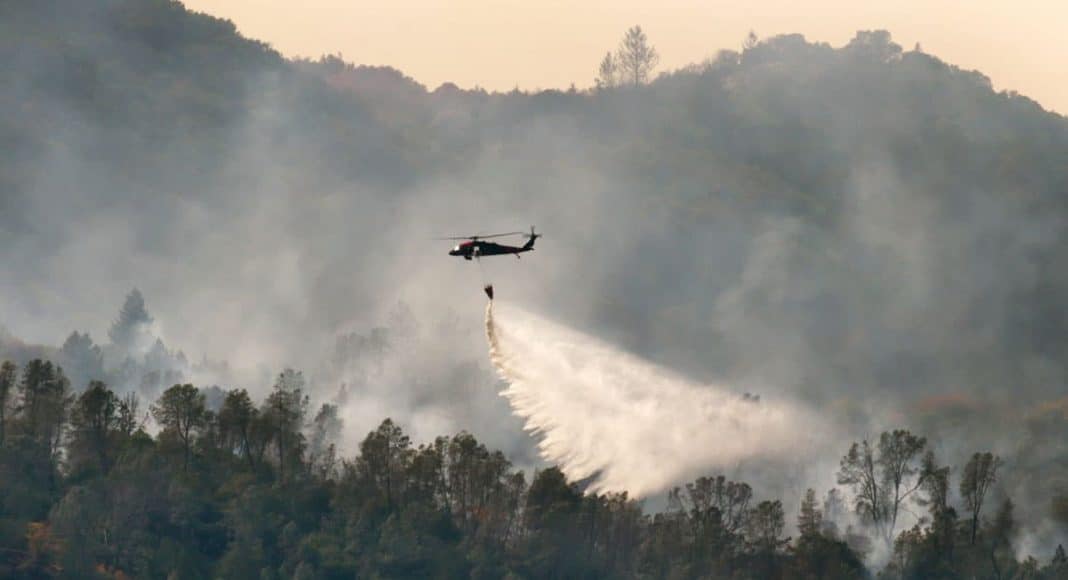“We have never recorded higher levels of air pollution in the Bay Area,” said air district spokeswoman Kristine Roselius.
While a limited number of deaths have been reported thus far, the public health impacts of this disaster will be felt for many months to come. This is not a typical wildfire; in Santa Rosa, flames have melted gas pipes, power lines, even a cellphone tower. The blaze has scorched thousands of homes and cars, releasing metals into the air. Rubber, fiberglass, paint, and electrical equipment burn to uncommon and highly dangerous toxins, such as dioxins and other biphenyl compounds.
Poisons contained in the smoke will slowly fall from the air and be absorbed by plants and the watershed, contaminating agricultural crops, including those in the Emerald Triangle, America’s cannabis breadbasket. The timing couldn’t have been worse for cannabis farmers as these fires came at the start of harvest season. Cannabis producers and consumers need to be cautious about the chemicals that could accumulate.
There are three common ways that toxins and carcinogens in smoke can be removed from the atmosphere:
- Volatile chemicals like formaldehyde and carbon monoxide will dissipate by reacting with trace gasses in the air, perturbing the concentration of ozone and other gasses. When carbon monoxide reacts with oxygen radicals, for example, it converts to carbon dioxide.
- Hardier chemicals may be removed from the sky by wet deposition, whereby rain pulls pollution out of the atmosphere. But that requires precipitation. And if it rains, highly toxic run-off will pollute the watershed.
- Other chemicals will simply fall from the sky and deposit onto plants, soil, and other solid surfaces. These compounds include benzene, polycyclic aromatic hydrocarbons, and dioxins. The chemicals that settle on cannabis or nearby water and soil can be absorbed by the plant and passed on to the consumer. Cannabis, a bioaccumulator, will uptake heavy metals from the soil that have deposited on the ground.
While these toxins can pose serious health hazards, it is important not to exaggerate harms. Cannabis smoke (even from untainted, organically grown cannabis) also contains carcinogens, but smoking marijuana does not increase the risk of oral and lung cancers—possibly because THC, CBD, and other plant cannabinoids exert a direct anti-tumor action against oral and lung cancer.
Another factor that may mitigate harm from inhaled cannabis smoke is the inhibition of a group of enzymes called CYP1A. Polycyclic aromatic hydrocarbons become more carcinogenic when metabolized by CYP1A enzymes in the body: By inhibiting CYP1A in the lungs, cannabinoids could reduce the activation of these carcinogens.
In cannabis smoke, roughly 0.5% of the plant material converts to polycyclic aromatic hydrocarbons. That is 5000 parts per million by weight (ppm). Carcinogenicity of aromatic hydrocarbons is usually discussed at concentrations on the order of 10 ppm. It remains to be seen if toxins deposited by the fires will be greater than the concentrations normally found in cannabis smoke. If not, then this cannabis is likely safe to consume (though it may require a warning under prop 65). To reduce further toxicity, it would be best for people to avoid smoking cannabis tainted by the wildfires: vaporization and ingestion are alternatives.
But consumers should also be aware that extraction processes (including butane, ethanol, and CO2) may concentrate these unwanted chemicals, though this is not precisely known. Cannabis producers and consumers should make sure, if possible, that any lab tests apply to the final product, not just the plant material that was used for extraction.
Accurate testing is paramount. Unfortunately, some cannabis labs have a record of providing results before they have validated their methods and can be certain that their numbers are correct. (Validation involves spiking precise amounts of contaminants into clean cannabis samples to ensure that accurate results are obtained.)
Several fire-generated toxins that may be deposited on cannabis crops—including benzene and toluene—are on the list of regulated solvents that California labs will likely have to quantify in cannabis products as of 2018. In preparation for the upcoming regulations, analytical labs may have already validated methods for detecting these compounds.
- Related Story: California Marijuana Harvest Jeopardized By Wildfires
But other, less common toxins, such as benzopyrenes and polychlorinated dibenzo dioxins (PCDDs; sometimes simply called dioxins), are not included in the new regulations. Dioxins are particularly important: they are formed when chlorinated plastics burn, such as PVC pipes. One kind of dioxin, which is called TCDD, disrupts endocrine, immune, and reproductive systems as well as fetal development. It is also a carcinogen at larger concentrations. (TCDD was also a contaminant in Agent Orange, a chemical weapon created by Monsanto and used in the Vietnam war.)
Whether mandated by state regulations or not, cannabis labs should also test for these compounds. Thus far, however, cannabis labs have not validated testing procedures for these compounds.
Another concern: helicopters and planes have been dumping tons of fire-repellant in an effort to contain the fires. The fire-repellant used, another Monsanto-designed product called Phos-Chek, may also have adverse health consequences. One of the main constituents of Phos-Chek is ammonium salt. Ammonium is a fertilizer: If absorbed through the plant, it is unlikely to be toxic, but smoking or vaporizing ammonium stuck on cannabis resin should be avoided.
Project CBD hopes that some lab in California will validate methods and offer tests to detect the major contaminants that result from the wildfires. We expect these will include benzene, toluene, benzopyrenes, and heavy metals, as well as some dioxins and polychlorinated biphenyls.
Adrian Devitt-Lee, a Project CBD contributing writer, is a senior research associate with CannaCraft.
This story originally was published by Project CBD, a California-based nonprofit dedicated to promoting and publicizing research into the medical uses of cannabidiol and other components of the cannabis plant.


